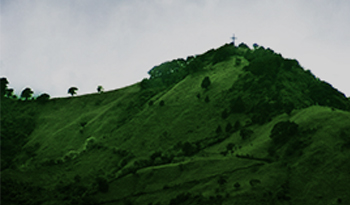Life in Alajuelita

Alajuelita is generally considered quiet, peaceful, and traditional. Many resident families go to church on Sunday morning or spend days in the park where their kids play in courtyard, basketball courts, or football fields.
Alajuelita is surrounded by lush, green mountains and rivers, such as Río Tiribí, Río Cañas, and Río Poás. But the town also offers many modern conveniences. In Alajuelita, one can easily find small grocery stores, larger supermarkets, drugstores, restaurants, pubs, coffee shops, and public or private schools.
In Alajuelita, many celebrate the “Santo Cristo de Esquipulas,” in honor of the famous Black Christ of Esquipulas, or “El Cristo Negro,” located in Guatemala. (Two competing theories explain the color of El Cristo Negro. The first theory suggests that El Cristo Negro’s black color was the result of sheer administrative oversight. Specifically, that when the figure of Christ was first commissioned, no one specified to the artist that the color of figure be white. Thus, the artist delivered the sculpture in the naturally dark color of the wood from which it was made, which was accepted by the church. Another theory credits the artist as being a person of grand philosophical vision, who knew that the black Christ would be heralded as a work of national importance that would tether the suffering inflicted on the native population with the suffering endured by Christ.) In 1933, Alajuelita erected a large cross structure on the top of the mountain known as Cerro San Miguel, where many people make pilgrimage to the honor El Cristo Negro.
Alajuelita has a central park located in front of the cathedral Parroquia Nuestra Señora de Los Dolores. Also near the park is the National Sanctuary of Santo Cristo de Esquipulas, a museum-like building with pictures, paintings and sculptures about Cristo Negro. For years, pilgrims and tourists from around the world have visited this sacred area.
During the first week of January, the central park turns in to an amusement park, with fun rides for both adults and children. Many families and friends attend, enjoying the typical dishes of chorreadas and tamales and beverages like chinchiví and chichi. Both chinchiví and chichi are alcoholic drinks made from a corn fermentation process and drank by locals during celebrations.
Restaurants on the mountain top (also called “miradores”) are famous for their amazing view. While they serve a variety of food, they are best known for their typical Costa Rican food (including picadillos, chicharrones, gallo pinto) and diferent kind of appetizers (called “bocas”). The most popular of the miradores is the “Ranchitico,” where families go on weekends to enjoy live music and dinner while viewing the San Jose city lights below.




